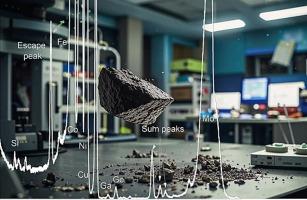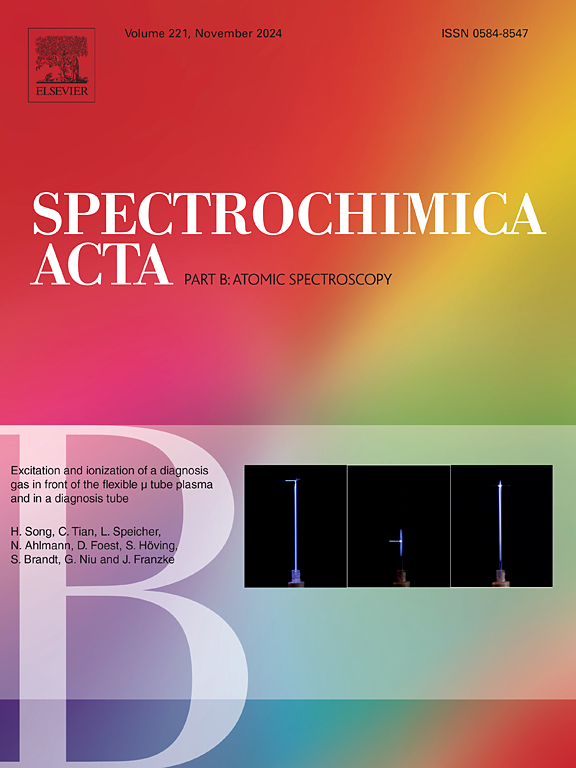全反射x射线荧光(TXRF)光谱法分析铁陨石元素:在锡霍特-阿林陨石上的新应用
IF 3.8
2区 化学
Q1 SPECTROSCOPY
引用次数: 0
摘要
铁陨石的分类是基于它们的结构和元素组成。以Ni、Ga、Ge、Co、Au和Ir质量分数为主要依据,将铁陨石分为13类。在这项工作中,探讨了使用TXRF方法分析铁陨石元素的潜力。由于缺乏铁陨石的认证标准物质,由于元素组成的高度均匀性,选择了Sikhote-Alin陨石进行方法学研究。建立了采用6 M硝酸分解、无标定量方法测定Fe、Ni、Ga和Ge的TXRF方法。采用MIBK液液萃取法去除基体中的Fe,同时测定Co和Cu的含量。Fe、Ni、Cu和Ge的精度不超过4%,Co的精度不超过8%,Ga的精度不超过11%。根据回收率,各元素的准确度一般在90 - 110%之间。TXRF方法能够在第一个微克/克(μg/g)水平上进行检测,并且被认为对大多数类型的铁陨石都是令人满意的。本文章由计算机程序翻译,如有差异,请以英文原文为准。

Method for elemental analysis of iron meteorite by total-reflection X-ray fluorescence (TXRF) spectrometry: novel application to Sikhote-Alin meteorite
Classification of iron meteorites is based on their structure and elemental composition. The chemical composition classification is based, especially on Ni, Ga, Ge, Co, Au and Ir mass fractions and divides iron meteorites into 13 groups. In this work, the potential of elemental analysis of iron meteorites using the TXRF method is explored. In the absence of certified reference materials for iron meteorites, the Sikhote-Alin meteorite was chosen for methodological research due to its high degree of homogeneity in elemental composition. The TXRF method was developed for the determination of Fe, Ni, Ga, and Ge following 6 M nitric acid decomposition and a standardless quantification approach. Liquid-liquid extraction with MIBK was employed to remove Fe from the matrix, and Co and Cu were also determined. The precision did not exceed 4 % for Fe, Ni, Cu, and Ge, 8 % for Co, and 11 % for Ga. The trueness, based on recovery values, was generally in the range of 90–110 % for all elements. The TXRF method enabled detection at the first microgram per gram (μg/g) levels and was considered satisfactory for most types of iron meteorites.
求助全文
通过发布文献求助,成功后即可免费获取论文全文。
去求助
来源期刊
CiteScore
6.10
自引率
12.10%
发文量
173
审稿时长
81 days
期刊介绍:
Spectrochimica Acta Part B: Atomic Spectroscopy, is intended for the rapid publication of both original work and reviews in the following fields:
Atomic Emission (AES), Atomic Absorption (AAS) and Atomic Fluorescence (AFS) spectroscopy;
Mass Spectrometry (MS) for inorganic analysis covering Spark Source (SS-MS), Inductively Coupled Plasma (ICP-MS), Glow Discharge (GD-MS), and Secondary Ion Mass Spectrometry (SIMS).
Laser induced atomic spectroscopy for inorganic analysis, including non-linear optical laser spectroscopy, covering Laser Enhanced Ionization (LEI), Laser Induced Fluorescence (LIF), Resonance Ionization Spectroscopy (RIS) and Resonance Ionization Mass Spectrometry (RIMS); Laser Induced Breakdown Spectroscopy (LIBS); Cavity Ringdown Spectroscopy (CRDS), Laser Ablation Inductively Coupled Plasma Atomic Emission Spectroscopy (LA-ICP-AES) and Laser Ablation Inductively Coupled Plasma Mass Spectrometry (LA-ICP-MS).
X-ray spectrometry, X-ray Optics and Microanalysis, including X-ray fluorescence spectrometry (XRF) and related techniques, in particular Total-reflection X-ray Fluorescence Spectrometry (TXRF), and Synchrotron Radiation-excited Total reflection XRF (SR-TXRF).
Manuscripts dealing with (i) fundamentals, (ii) methodology development, (iii)instrumentation, and (iv) applications, can be submitted for publication.

 求助内容:
求助内容: 应助结果提醒方式:
应助结果提醒方式:


